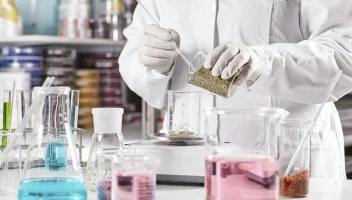Unlocking DNA Copyright Protection with Sequence Searches, Part 1
Unlocking DNA Copyright Protection with Sequence Searches, Part 1
Unlocking DNA Copyright Protection with Sequence Searches, Part 1
16 Mei 2018
Aptean Staff Writer
We welcome back guest blogger and thought leader Professor Chris Holman at the University of Missouri-Kansas City Law School for a new two part series. Professor Holman authors the well-known Holman’s Biotech IP Blog and is the executive editor of Biotechnology Law Report.
In a recent series of posts, I explored the idea of extending copyright protection to engineered DNA sequences. Given Aptean's status as a leading provider of patent sequence search services, I thought it would be interesting to write a post considering what role sequence searching might play under a legal regime that recognizes copyright protection for engineered genetic sequences.
If copyright protection becomes available for a significant number of engineered genetic sequences, copyright sequence searching could become just as relevant as patent sequence searching. For one thing, the Copyright Office might incorporate sequence searching into its copyright registration processes. Users of pre-existing DNA sequences, including synthetic biologists engineering new genetic code, or firms involved in the manufacture, sale and/or distribution of DNA and DNA-based products, might also be well advised to perform a copyright sequence search to ascertain, or at least confirm, the copyright status of all pre-existing DNA sequences used in their work.
This post will focus on the incorporation of DNA sequence searching into the Copyright Office’s registration function. Stay tuned for Part 2 of this series, where I plan to discuss the utility of copyright sequence searching for third party users of pre-existing DNA sequences, analogous to the current practice of performing a patent sequence search to assess
Understanding the Differences Between Patent and Copyright Requirements
For readers more familiar with patent prosecution than copyright registration, it might come as a surprise to learn that, as a general matter, the Copyright Office does not perform any sort of novelty search when examining a work that has been submitted for registration. In contrast, the Patent and Trademark Office (“PTO”) routinely performs sequence searches in order to identify prior art that could undercut the novelty and nonobviousness of a patent claim reciting a DNA sequence. This distinction reflects the less stringent requirements for copyrightability.
In particular, there is no novelty or nonobviousness requirement for copyright – so long as a work is the product of independent creation and incorporates some minimal degree of creativity, it is copyrightable. No matter how similar (or even identical) it might be to the previous work of another.
Copyright Office’s Response to an Attempt to Register an Engineered DNA Sequence
Interestingly, however, the Copyright Office recently seemed to take the position that a novelty search should be a prerequisite to registration of an engineered DNA sequence. As mentioned in a previous post, Professor Andrew Torrance of the University of Kansas School of Law and I recently teamed up with DNA2.0, a leading gene synthesis company, in an attempt to register an engineered DNA sequence with the Copyright Office as a copyrighted work. We appealed the Copyright Office’s decision to deny registration, and received a letter from the Office’s Director of Copyright Policy and Practices affirming the Copyright Office’s position that engineered DNA is not copyrightable subject matter.
The letter provided a number of purported rationales for the Office’s determination that DNA cannot be copyrighted (none of which we found convincing). Of particular relevance to the current discussion, one of the Office’s justifications was its assertion that it lacked the ability to examine our submitted sequence to assess whether it was truly a work of “creative human authorship,” as opposed to a “naturally-occurring sequence, or a derivation thereof.” This implies that the Office believes that if engineered DNA was copyrightable, it would be incumbent upon the Office to perform some sort of sequence search to ascertain whether the sequence is truly a work of human engineering, as opposed to an uncopyrightable naturally-occurring sequence, or a derivative of a naturally-occurring sequence lacking sufficient independent creativity to crossover the threshold into copyrightable subject matter.
Search is the Key to Enabling Engineered DNA Copyright Protection
I tend to agree with the Copyright Office on this point, to the extent that I believe that if the Copyright Office begins registering engineered DNA sequences, it should perform a search to confirm the originality of the submitted sequence, i.e., that the sequence is not too close to a naturally-occurring sequence, nor is it too close to another’s previously disclosed engineered sequence. Even though the standard for copyright is originality, not novelty, in most instances involving a relatively complex sequence, a lack of novelty would (for all practical purposes) establish lack of originality. As an analogy, while a composer might truthfully assert that she has independently come up with a simple tune that happens to be the same as one already existing in the public domain, an author would not be able to credibly argue that he has independently authored a novel identical to Moby Dick.
However, I strongly disagree with the Copyright Office’s suggestion that its inability to perform novelty searches is a justification for denying registration for engineered sequences. If engineered DNA is determined to be copyrightable, the Office will be required to provide a mechanism for their registration, just as they are for any copyrightable work. And if the Office determines that a novelty search should be a prerequisite to registration, it will become incumbent upon the Office to develop the capability for performing such a search. When inventors began filing patent applications with claims reciting DNA sequences the PTO did not have the internal capability of performing patent sequence searches, but it responded by developing the capability and implementing rules relating to nucleotide and amino acid sequence disclosure, search and examination.
Reforming the Copyright System to Accommodate DNA Sequence Searching
This does not necessarily mean that the Copyright Office would have to develop in-house DNA sequence search capabilities – it could , or perhaps another public agency. On this point, a group calling itself the Copyright Principles Project (CPP) recently published a White Paper outlining various proposals for reforming the copyright system, one of which is for the Copyright Office to “transition away from being the sole registry for copyrighted works and toward certifying the operation of registries operated by third parties, both public and private.” The CPP describes itself as twenty people having “various kinds of expertise and experience with copyright law and policy, including law professors, lawyers from private practice and lawyers for copyright industry firms.” While acknowledging that their proposal to outsource some of the Office’s registry function to third-party contractors might be considered “radical,” they argue that such a move would be justified by the “reality that the functionality of the [Copyright Office’s] registry remains woefully behind what leading-edge search and database technologies permit.” The CPP states that “the basic idea…would be to shift the Copyright Office away from day-to-day operation of the copyright registry and toward a role of setting standards for and superintending a system of separate but networked and interoperable private registries.”
Under the CPP proposal, a private company such as GQ Life Sciences from Aptean could provide the Copyright Office with the DNA search capability it would need to perform novelty searches in conjunction with registration of engineered sequences, and handle the day-to-day operation and maintenance of the searchable database, while the Office oversees the process. This approach would have the merit of facilitating efficient search and registration of copyrightable engineered sequences, thereby enabling the Office to deny registration of a sequence that appears too close to naturally-occurring sequences, or perhaps to a previously registered sequence.
It would also allow the Copyright Office to take advantage of the well-developed expertise and curated databases maintained by a private search firm such as GQ Life Sciences from Aptean, rather than requiring the Office to build up its own capabilities in this area from scratch.
With its extensive data coverage (over 500 million sequences), powerful search tools and user-friendly functionality, Aptean GenomeQuest is the obvious choice for searching the entire sequence domain, both patent and non-patent.
Avoid the pitfalls of using free solutions for IP sequence searching. Download our RFP template or start a free trial today!
About Chris Holman
Chris Holman is a Professor at University of Missouri-Kansas City Law School, as well as the author Holman’s Biotech IP Blog and Executive Editor of Biotechnology Law Report. GQ Life Sciences is thrilled to have him be a guest blogger.
Related Content


Klaar om te zoeken naar IP-sequenties
Gebruik ons gratis Request for Proposal (RFP)-sjabloon om de juiste IP-sequentieoplossing voor uw bedrijf te vinden.






